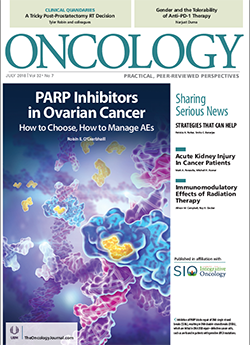Narjust Duma on How Gender Affects the Tolerability of Immunotherapy
In this interview, we discuss a study of sex differences in the tolerability of anti–programmed death 1 immunotherapy among patients with metastatic melanoma.
Oncology (Williston Park). 32(7):332-3.

Narjust Duma, MD

As part of our coverage of the American Society of Clinical Oncology (ASCO) Annual Meeting held June 1–5 in Chicago, ONCOLOGY spoke with Narjust Duma, MD, a hematology and oncology fellow at the Mayo Clinic in Rochester, Minnesota, who served as lead author on a study of sex differences in the tolerability of anti–programmed death 1 (anti–PD-1) immunotherapy among patients with metastatic melanoma.
1.What led you to examine sex differences in the tolerability of immunotherapy?
Dr. Duma: Most research projects start at the bedside. During my time on the inpatient oncology service, I observed several patients with grade 3 immune-related adverse events admitted to the hospital. After several weeks, we noticed most of the patients were women receiving immune checkpoint inhibitors.
While this sample was skewed towards severe adverse events in a tertiary center, we decided to investigate if our observation was the same in the outpatient setting.[1]
2. Among patients at the Mayo Clinic Rochester who received anti–PD-1 immune checkpoint immunotherapy for metastatic melanoma, you found that premenopausal women had a higher rate of immune-related adverse events (IRAEs) leading to treatment discontinuation than postmenopausal women, and that both groups of women had higher rates than men, correct?
Dr. Duma: Yes, despite a small sample size (30 premenopausal women), we observed that premenopausal women had higher rates of IRAEs and were more likely to discontinue their anti–PD-1 agent due to toxicity (irrespective of the clinical benefit they had obtained from the treatment).
These differences were observed when comparing [premenopausal patients] with postmenopausal women and men with metastatic melanoma.
3. The differences were limited to lower-grade (grade 1 and 2) IRAEs, correct?
Dr. Duma: We did not observe differences in IRAEs higher than grade 3, meaning most of the difference came from grade 2 adverse events. One of the challenges while conducting studies like ours is that grade 1 adverse events are often under-documented. We hope to continue our work in this area and conduct a large prospective study where data regarding adverse events of all grades will be well documented and later analyzed.
4. Did the site of metastasis affect IRAE risk?
Dr. Duma: Previous observations suggested that patients with liver metastases were more likely to develop IRAEs. In our cohort, we did not find a correlation between liver, lung, or brain metastases and risk of developing IRAEs. We are planning to conduct further analysis regarding the association of primary tumor location and IRAEs.
5. Were there trends for specific types of IRAEs?
Dr. Duma: When analyzing IRAEs in subcategories (by organ involvement), we observed that women were more likely to develop endocrinopathies such as hypothyroidism, adrenal insufficiency, etc. In the general population, women are more likely to develop hypothyroidism during their lifetime compared to men.
6. Might sex hormones be a factor there?
Dr. Duma: Perhaps sex as a biologic variable plays an important role in the development of IRAEs and in the differences between the sexes in this area. Further studies are necessary to understand the etiology of these mechanisms and the role of sex hormones in the development of IRAEs.
7. Were there demographic or clinical variables in addition to patient sex that affected IRAE risk?
Dr. Duma: We conducted a multivariable analysis to try to identify other risk factors for the development of IRAEs. We did not observe any significant association besides sex. Included in the analysis were specific tumor characteristics and mutations; history of prior radiation, chemotherapy, or colony-stimulating agents; and comorbidity indexes. None of these were statistically significant.
8. How did IRAEs affect patient outcomes?
Dr. Duma: We failed to observe a meaningful difference in progression-free survival between the women with IRAEs and those without, but this could have been in part due to our small sample size in the premenopausal group.
On the other hand, we captured a trend towards better progression-free survival in men who developed IRAEs, suggesting an association between immune system “hyperactivation” and response to therapy. We are collecting more data from our sites in Florida and Arizona with the hope of increasing our sample size. This project has been an enterprise-wide effort.
9. What implications do your team’s findings have for the use of immune checkpoint blockade regimens in women?
Dr. Duma: At this time, we believe we need further studies to better understand our observations, but these findings bring attention to a very important issue: women are biologically different and may require closer monitoring while receiving treatment with anti–PD-1 therapy for metastatic melanoma. As more trials utilizing anti–PD-1 agents are opening every day, we hope that the data regarding adverse events will be reported by sex and that larger studies can be conducted with the existing data.
10.How should your findings affect monitoring for immune checkpoint inhibition–associated IRAEs?
Dr. Duma: The treatment landscape of multiple malignancies has changed with the introduction of immune checkpoint inhibitors. Clinical practices should adapt to these changes. Our questions regarding adverse events are shifting away from the traditional nausea, vomiting, etc to the new-rashes, joint pain, and cough, for example.
ASCO recently released guidelines for the treatment of IRAEs; we invite everyone to review them. Consistent practices would allow our patients to receive the best care independent of whether they are treated at a tertiary center or in a community practice.
Financial Disclosure:The author has no significant financial interest in or other relationship with the manufacturer of any product or provider of any service mentioned in this article.
References:
1. Duma N, Paludo J, Enninga EA, et al. Sex differences in tolerability to anti-PD1 therapy. Are we all equal? J Clin Oncol. 2018;36(suppl):abstr 9547.
2. Brahmer JR, Lacchetti C, Schneider BJ, et al. Management of immune-related adverse events in patients treated with immune checkpoint inhibitor therapy: American Society of Clinical Oncology clinical practice guideline. J Clin Oncol. 2018;36:1714-68.
